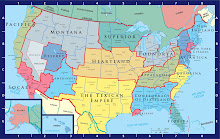(The Texican Empire)

AREA
594,000 sq.m. (3rd)
POPULATION
42,792,000 (1st)
DENSITY
72 people per sq.m. (14th)
CAPITAL
Dallas, East Texas
STATES
Louisiana (Shreveport), Arkansaw (Little Rock), Oklahoma (Oklahoma City), East Texas (Fort Worth), Alamo (Austin), Comancheria (Amarillo), West Texas (Lubbock), Tejas (Corpus Christi), New Mexico (Roswell).
RELIGION
Protestant, Catholic, various
LANGUAGE
English, Spanish
NATL INCOME
2,175 billion
MEDIAN INCOME
$50,838 (9th)
ECONOMY
The Texican Empire has probably the strongest economy on the continent. It’s extremely rich in both natural resources and farmland, and its cities like Houston, Dallas and Austin are heavy centers of industry, finance, chemicals, defense, engineering and high-tech growth. As a result, it has the rare ability to be almost completely independent of foreign nations. It does, however, make a significant amount of money from exports to smaller countries, especially in the Caribbean and Central and South America. It generally runs competitively to the ANTU nations and is viewed as an aggressive expansionist, both in terms of business and territory (Texico recently annexed three states from the government of Mexico, almost doubling its size and population). Texico does maintain trade with Dixieland, Appalachia and Mexico, and occasionally, Heartland. The cost of living is median in most areas.
OVERVIEW
Texas was originally the only new nation created by the Division of 1980 made up of a single state (outside of Alaska and Hawaii). This was due both to its size and its extraordinary resources and independence. Three men – Governor John Connally and Senators George Bush and Lloyd Bentsen – were almost single-handedly responsible for the construction of the new nation and its position as a strong international presence right from the beginning. After President Bentsen was assassinated in a Dallas motorcade in 1983 by a Mexican-Marxist radical, President Connally implemented an aggressive foreign policy and economic structure, and by the end of the decade, Texas was firmly established as a plutocracy, with the dominant Lone Star Party being tied heavily into business and the oil industry. In the late 80s, Texas annexed Arkansas from Heartland (wanting access to the Mississippi River), and later invaded Oklahoma, leading to the bloody Oklahoma Border War. Both states would eventually fall to Texas, as would most of Louisiana. In 1996, Democrat Phil Gramm was elected, but soon proved in the eyes of the international community to be merely a figurehead administration designed to allow the Lone Stars a convenient return to power. The administration of Tom Delay almost led Texico (as it had been called since a famous speech by President G. Bush spelling out Texico’s manifest destiny to control Central America) to war with Atlantica and other ANTU nations over the territory of Cancun, which the Mexican government was considering selling. In early 2004, Mexican-Marxist suicide bombers destroyed part of the Alamo in retaliation for what they viewed as Texico’s harmful economic and immigration policies. Texico immediately mobilized its forces and sent tanks rolling across the border into three Mexican states, where they were greeted as liberators by a populace sick of the weakened and corrupt Mexican PRI party. Texico still holds territory in Mexico, despite condemnation by the international community, and the situation has devolved to a legitimate border war between the two nations. There is some question whether new president John Ellis Bush will resolve the situation in peace by withdrawing troops, or escalating the fighting by a full-scale attack on the rest of Mexico.
HEAD OF STATE

President John Ellis Bush,
Lone Star Party

Vice President Karl Rove,
Lone Star Party.

No comments:
Post a Comment